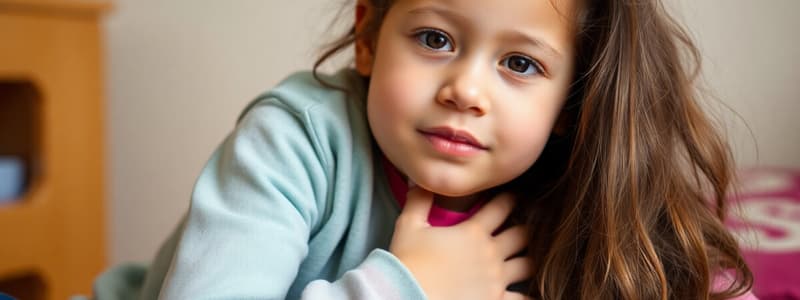Podcast
Questions and Answers
What is a key characteristic of a child who has achieved normal developmental milestones?
What is a key characteristic of a child who has achieved normal developmental milestones?
- Lacks emotional responses to situations
- Has no understanding of social cues
- Avoids interaction with adults
- Seeks out adults for nurturance when needed (correct)
Which of the following is classified under trauma-related disorders in adults?
Which of the following is classified under trauma-related disorders in adults?
- Bipolar Disorder
- Posttraumatic Stress Disorder (correct)
- Obsessive-Compulsive Disorder
- Generalized Anxiety Disorder
Which event is NOT likely to induce PTSD?
Which event is NOT likely to induce PTSD?
- Crime-related events
- Combat situations
- Minor disagreements (correct)
- Natural disasters
What is a common symptom of Acute Stress Disorder?
What is a common symptom of Acute Stress Disorder?
Which treatment modality is often recommended for individuals experiencing PTSD?
Which treatment modality is often recommended for individuals experiencing PTSD?
How long can Acute Stress Disorder symptoms persist following a traumatic event?
How long can Acute Stress Disorder symptoms persist following a traumatic event?
What is a key characteristic of Reactive Attachment Disorder?
What is a key characteristic of Reactive Attachment Disorder?
Which of the following is NOT a symptom of PTSD?
Which of the following is NOT a symptom of PTSD?
Adjustment Disorder can be described as a:
Adjustment Disorder can be described as a:
Which symptom is commonly associated with Posttraumatic Stress Disorder in children?
Which symptom is commonly associated with Posttraumatic Stress Disorder in children?
Which factor is NOT identified as a risk for Posttraumatic Stress Disorder?
Which factor is NOT identified as a risk for Posttraumatic Stress Disorder?
What is a common behavioral response associated with Acute Stress Disorder?
What is a common behavioral response associated with Acute Stress Disorder?
Which of the following does NOT describe a typical aftermath of trauma in individuals with PTSD?
Which of the following does NOT describe a typical aftermath of trauma in individuals with PTSD?
What intervention is recommended for children with PTSD?
What intervention is recommended for children with PTSD?
What is a primary goal in establishing a child's trust during PTSD interventions?
What is a primary goal in establishing a child's trust during PTSD interventions?
Which of the following is a common manifestation of PTSD in preschool-aged children?
Which of the following is a common manifestation of PTSD in preschool-aged children?
What is an important aspect of handling anxiety in children with PTSD?
What is an important aspect of handling anxiety in children with PTSD?
What role do caregivers play in the treatment process for a child with PTSD?
What role do caregivers play in the treatment process for a child with PTSD?
Which of the following is a sign of effective PTSD treatment in children?
Which of the following is a sign of effective PTSD treatment in children?
Which of the following disorders is characterized by a lack of normal fear of strangers?
Which of the following disorders is characterized by a lack of normal fear of strangers?
Flashcards are hidden until you start studying
Study Notes
Trauma-Related Disorders
- Associated with a wide range of psychiatric disorders, other medical disorders, and trauma.
- Trauma-informed care is important and aims to not further traumatize the patient.
Attachment Disorders
- Reactive attachment disorder is characterized by emotional detachment.
- Disinhibited social engagement disorder presents as a lack of normal fear of strangers.
Posttraumatic Stress Disorder
- In children, PTSD presents with a reduction in play or play reflecting aspects of the trauma.
- In adults, PTSD presents with flashbacks, avoidance, and alterations in mood.
- Hypervigilance, irritability, anger or agitated behavior are persistent symptoms of increased arousal.
Risk Factors for PTSD in Children and Adolescents
- Neuroplasticity, dependence on adult caregivers and systems.
Interventions for Child PTSD
- Use interactive processes to establish trust and safety.
- Utilize developmentally appropriate language when communicating.
- Teach relaxation techniques before trauma exploration to restore a sense of control.
- Incorporate art and play into treatment to facilitate the expression of emotions.
- Involve caregivers in the treatment process to provide guidance and support.
- Educate the caregivers about various treatments and therapies.
- Coordinate with caregivers and social workers to ensure the child receives comprehensive care.
- Assist caregivers in resolving their own emotional issues, which may be impacting the child's well-being.
Evaluation for Child PTSD
- Effective treatment is observed when safety is ensured, anxiety is reduced, emotions and behaviors are appropriate, the child has achieved normal developmental milestones, and is confident seeking adult support when needed.
Post-traumatic Stress Disorder in Adults
- PTSD can be triggered by a wide range of traumatic events, such as combat, hostage situations, crimes, natural disasters, and accidents.
- PTSD symptoms in adults include flashbacks, avoidance of trauma-related stimuli, persistent negative thoughts and feelings, alterations in mood, and hyperarousal.
Treatment Modalities for PTSD
- SSRI's, antidepressants.
Acute Stress Disorder
- Develops within 3 days to 1 month following a highly traumatic event.
- PTSD can be diagnosed within the first month following a traumatic event.
- Symptoms include intrusive memories, avoidance behaviors, negative thoughts and emotions, sleep disturbances, and hypervigilance.
Adjustment Disorder
- A milder and less specific version of ASD or PTSD.
- Precipitated by a stressful life event.
Studying That Suits You
Use AI to generate personalized quizzes and flashcards to suit your learning preferences.


